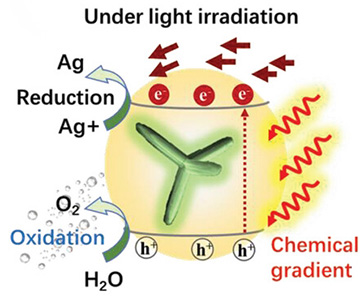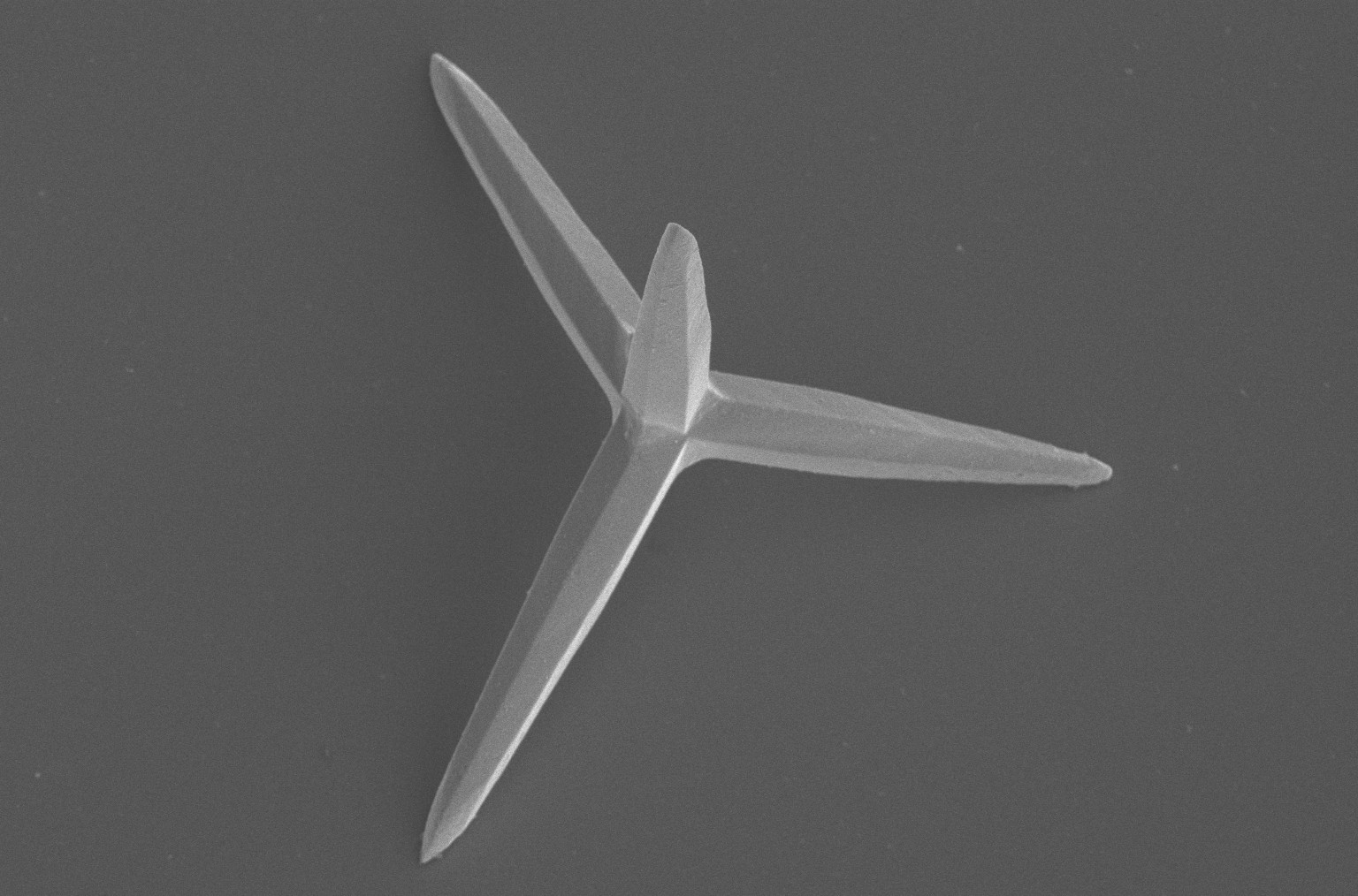A research team in Spain has devised a straightforward chemical approach for creating four-pronged microcrystals of silver phosphate (AgPO4) that can act as light-driven, bacteria-killing micromotors. (The arm length is approximately 5 µm.) [Image: ICIQ]
Researchers from several institutions in Spain have used straightforward lab chemistry to create four-pronged, light-driven micromotors made of silver salts (Adv. Opt. Mater., doi: 10.1002/adom.202303137). The team believes these tetrapod microcrystals could eventually prove potent weapons in the fight against food- and water-borne pathogens in the environment.
When activated by UV or visible light, the team’s micro-tetrapods buzz through aqueous media, throwing off silver ions and reactive oxygen species that clog cell membranes and inactivate or kill pathogenic bacteria. As an added bonus, the micromotors gradually self-destruct while doing their dirty work, leaving the water free of the tetrapod crystals after treatment. The researchers believe their work on these diminutive bacterial nemeses could prove significant in “designing and developing the next generation of light-driven antimicrobial agents.”
Ag+, bacteria slayer
Silver salts actually have a long antimicrobial history—stretching back to ancient Greece and Rome, where they are said to have been applied three millennia ago to wounds to prevent infection. The salts’ effectiveness traces to the well-known antibacterial properties of silver (Ag+) ions. These ions act to gum up bacterial cell membranes, preventing life-sustaining transport of material into and out of the pathogen. And those Ag+ ions that penetrate into the bacterial cell body itself go on to wreak havoc on processes related to cell division and energy production.
In recent years, researchers have examined how various types of silver-containing microparticles might address specific environmental problems, such as contamination of water by organic pollutants or pathogenic bacteria. Attention has lately focused especially on microparticles of one particular silver salt, silver phosphate (AgPO4), as a candidate for light-driven micromotors that could neutralize bacterial contamination. Previous work has established that the shape of such microcrystals can have a big impact on both their light-induced mobility and their bactericidal effectiveness—with four-pronged, tetrapod crystals showing particular promise.
Making the micromotors
The team behind the new work—led by scientists at the Institute of Chemical Research of Catalonia and the Catalan Institute of Nanoscience and Nanotechnology, and also including researchers from the University of Zaragoza and the University of Barcelona—sought a better way to build such microcrystals, and a better understanding of how they work.
The team sought a better way to build light-driven, bacteria-killing micromotors, and a better understanding of how they work.
To address the first aim, the researchers devised and demonstrated a simple wet-chemistry approach to creating the tetrapod AgPO4 micromotor crystals—which the team calls TAMs. The approach involves mixing silver nitrate and an ammonia solution, and dripping the mixture slowly into a second solution of hydrated sodium phosphate. The approach puts tight guardrails around the reaction rate, allowing the four-legged microcrystals to precipitate out into a residue, which the team then separates and dries into a light-green powder.
The team used X-ray diffraction to characterize the crystal structure, and snapped high-resolution SEM photos of the micro-tetrapods (which had an average arm length of around 5 µm). The researchers also confirmed, via reflectance spectroscopy, that the crystals had excellent absorption characteristics in the UV-visible band. And they established that the tetrapods carry a positive surface charge. That’s potentially important for their bacteria-zapping effectiveness; the bacteria generally have a negative surface charge, which would thus tend to attract and bind the tetrapod killers to their prey.
Self-destructive tendencies
With a pile of the TAMs at hand, the team next tried out their mobility in water and glucose solutions, and also under irradiation from UV and blue light. Depending on the light wavelength and the medium, the tetrapods displayed either linear or rotational motion at varying speeds, zipping along at an especially brisk 8 µm/s in glucose under UV illumination.

The team believes the tetrapod micromotors’ light-driven motion stems from photocatalysis, which releases silver ions and leads to creation of reactive oxygen species in the surrounding fluid. The resulting chemical-concentration gradient drives microparticle forward. [Image: X. Yuan et al., Adv. Opt. Mater., doi: 10.1002/adom.202303137 (2024); CC BY-NC 4.0]
The light-driven motion, the team explains, is a result of photocatalysis. As the light hits the microcrystal, it causes the silver salt to react with the surrounding medium, releasing silver ions and also leading to the creation of reactive oxygen species. The various photocatalytically produced species diffuse through the solution at different rates, and the resulting concentration gradient drives the micromotors forward, in a process the authors refer to as “self-diffusiophoresis.” Moreover, as photocatalysis continues to spall off silver ions from the salt, the micromotor crystal itself gradually self-degrades and eventually disappears.
99.999% antibacterial effectiveness
Finally, the team tested the TAMs’ efficacy in killing pathogenic bacteria. To do so, the researchers set the tetrapod micromotors loose in petri dishes containing colonies of Escherichia coli, a Gram-negative bacterium, and Staphylococcus aureus, a Gram-positive variety, and illuminated them with blue light. By treating the bacteria with a “counterstain” that fluoresces red only in dead cells and then studying the scene under fluorescence microscopy, the team was able to establish an antibacterial effectiveness for the micromotors of more than 99.999% when illuminated by visible light.
The team cites several reasons for the TAMs’ excellent antibacterial chops. One is the well-established, strong basic antimicrobial properties of the Ag+ ions thrown off by the photocatalytic process—as well as the creation of bacteria-unfriendly reactive oxygen species such as oxygen ions, hydroxides and peroxides. Another reason is the positive charge of the tetrapods, which leads to their accumulation and more rapid photocatalytic activity in the area of negatively charged bacteria. And the researchers believe that the autonomous, light-driven movement of the TAMs—which could provide “significant advantages in breaking through biological barriers”—may play a role as well.
The authors write that their findings “introduce a new concept of self-degradable micromotors based on photocatalytic components, which hold great potential for their use in antimicrobial applications.” In particular, they think the vulnerability of both free-floating bacteria and biofilms to these light-driven micromotor warriors—as well as the simple chemical approach the team has demonstrated for making them—make TAMs “a promising alternative for environmental remediation.”

